Our two existing books are on post-Christmas and pre-release sale (those being Pamela Dean’s The Dubious Hills and Juniper, Gentian, and Rosemary).
Check the web page for details, including what it is that the release of is pre.
Our two existing books are on post-Christmas and pre-release sale (those being Pamela Dean’s The Dubious Hills and Juniper, Gentian, and Rosemary).
Check the web page for details, including what it is that the release of is pre.
We’ve finally got the first of Pamela’s books we’re republishing “fully” up on Amazon (print and Kindle). (Yes, you can get a discount for buying both print and ebook on Amazon; that’s the “Matchbook Price”.)
It’s also available through Smashwords for other ebook formats.

Okay, I’ve made surprisingly good time on the next cover, and have one which is getting close to ready even before I have the text all cleaned up.
This one started from one of my own photos, so let’s start there:

It’s really too large, and it’s brick rather than stone, but it’s not a bad starting point. Reducing it to B&W will make the brick less obtrusive, and simply cropping down will both make the doorway (and doorstep) more prominent, and hide the size of the entire building.
And I ended up here:

The biggest change to the main photo was applying the “rubber stamp” filter from the filter gallery to it. To get that to work out nicely, though, I had to adjust the curtains behind the windows, and the roof, and a number of other things. If you overlay the images you’ll find I’ve also performed some perspective distortion on the house—not actually important for this relatively tight crop, but I did it when the entire house was showing in a wraparound, and it was important there.

The house was done in two pieces; first I cropped and adjusted and prepared it for filtering, in four layers. The base layer is simply the image (with layer mask to clip the house out of the background). Then there’s a retouch layer which suppresses some things that are emphasized by the rubber stamp treatment. Then a curves layer with layer mask to brighten up foliage so it doesn’t go all black in the rubber stamp, and a curves layer with layer mask to darken the curtains inside the windows so the windows don’t go all white.
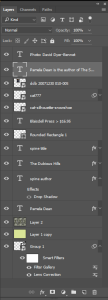
Then, that image was made one piece in the cover design. Working up, that image was placed to fit the front cover, the perspective was corrected, and the rubber stamp effect was applied. The opacity of that layer was reduced to get the gray I wanted (that was easier than repeating rubber stamp with different foreground colors selected until I found one I liked).
A simple color layer with “darken” blending mode applies the “background” color (this was easier than masking the rubber stamp group, I thought). Then the layer over that applies a very subtle texture to that background color, to keep it from looking perfectly flat.
The rest is really simple—text elements for title and author on cover and spine, the two cats (the white one will probably get more complicated, see below), the publisher and price on the back cover (and the background rectangle that makes it visible against the background), the author photo, the credit for the author photo, and the author biography.
I’m reasonably pleased with this, and it’s rather different from the last one (though both do involve buildings reduced to low-res B&W representations).
My current issue list for this:
Jumping back a book, since I don’t have anything really like a cover design for the current book yet.
I’ve never done a book cover before, and again (like the interior design) I’m not competent to do one. I feel like I got lucky this time, and will probably never make another cover this good.
Here’s what I ended up with:

This is a wraparound cover for a trade paperback. The light rectangle on the back near the spine is an approximation of where the ISBN barcode block will be put in by the POD provider. (I have to take that out before actually sending it to the POD provider, but I needed to know roughly where it was to avoid it blocking anything important).
What’s a cover for? Well, depends on how your book is being sold.
I think this one is going to be sold mostly to people who have heard of it, or at least have heard of Pamela, and that a lot of them will be specifically looking for the book after having heard it’s in print again. For those people, the cover is rarely important, and is more likely to be a negative influence than a positive (“I heard this book is good but look at that cover! Ewwww!”). Furthermore, I think the vast majority of sales will be online, and the cover is much less important there than when people have the book in their hands.
On the other hand, major publishers often sell most of the copies of their big sellers through airport news stands, Walmart, and so forth, and mostly to people who had no special intention of buying that book at the time. The requirements for this kind of cover are completely different (and I know even less about them).
The one thing it’s definitely not is an illustration of the story. It’s purpose is to grab attention. The cover is entirely a marketing piece, and it’s bad if it attracts people to the book who won’t like it (because they put out a stream of bad word-of-mouth).
What do covers have to have? Not much, really; it’s not about meeting requirements, but about successful design.
It’s generally thought important, at least by the author, to name the author of the book both on the cover and on the spine. (Okay, seriously, most dedicated readers buy by author a lot, so it is important.)
The book title is widely thought to be desirable information, both on the cover and on the spine.
If a book will be sold retail (direct by you, at convention dealers room tables, in bookstores, or whatever) a lot of people will look for the price somewhere on the cover.
If a book will be sold in retail settings with modern inventory setups (even independent bookstores are often so equipped, these days), they really want a bar code that their inventory system can work with (standard ISBN or UPC bar code).
Note that not one single one of those things was a requirement without caveats; nothing is absolutely required.
Being a photographer and familiar with Photoshop helped a lot. Being utterly unable to draw is a problem I had to work around.
Like oh-so-many self-published SF books, I started with a public-domain NASA image. Pamela found me this one, it’s Ophiuchus. Since Gentian is an astronomer, and does observe Ophiuchus in the book, it’s actually somewhat relevant.
It’s mentioned in the book, with little detail, that the original owners of the house had put an observatory dome on it. That makes the house itself, with the dome, a prime candidate for the cover. There are a very few houses around with observatory domes, but I didn’t find one I wanted to use as-is, or a local one that I could go photograph to my own satisfaction (I remember seeing one locally, but haven’t been able to find it again). The book doesn’t say much about exactly where the dome is on the house, and Pamela doesn’t even know; no constraints there!
So, time to invoke the modern meaning of the verb “to Photoshop”! I decided I’d graft the dome on in place of a pointed tower roof; lots of old big houses have a circular tower with a pointed roof, and that’s an easy place to put a circular dome. Furthermore, since we’re using the sky shot and emphasizing the astronomy, let’s render the house in silhouette.
So, now the hunt for houses. I ended up using a range of different source material, as models for different parts, and combine them fairly cleanly, with some modifications by me. I did quickly realize I had to somehow indicate window locations and such; a pure silhouette looked really stupid. So those got drawn in in 60 or so vector layers (so I could edit them to look semi-decent; I can’t draw well enough to get even straight lines right the first time). Luckily there are lots of observatory domes on record; easy to trace the outline and adjust the perspective to match the house.
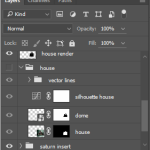
I’m a fairly sophisticated Photoshop user, so the house image you see is constructed from a lot of pieces. Those pieces are kept separate so far as possible; this makes it possible to experiment, refine only the ideas that work, and often change my mind later without having to throw out too much work (the actual work of the idea that didn’t work, yes; but often I don’t have to throw out the bits of associated work that interact with it but don’t depend on it). In particular I’m a huge fan of layer masks, both on actual bitmap image layers and on adjustment layers.
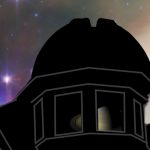
Late in the process, I realized it would be amusing to have a couple of windows show the view through the house to the sky; so I did that. (And, later, change it to showing a different astronomical view; I think it may be too small for people to even notice that, though; but those windows in the tower show through to a Cassini view of Saturn—an angle entirely impossible from Earth.)
I also decided to pinch in the waist of the house a little, to make it just slightly a caricature of a house rather than a “real” house.
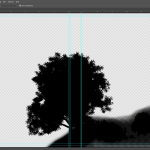
Now we’ve got a house floating in space over an astronomical photo. That’s not really very sensible-looking, even for a fantasy novel, so I decided to provide a ground reference. That’s easy to draw in in silhouette; but on examination, it looked pretty fake. Photoshop to the rescue again—Filter – Render – Tree! Yes, Photoshop has built-in fake trees now. That’s an ash to the left, and a spruce to the right.
There, done. Oh, no, wait; couple of things still needed. The title and author name were at least already decided, but I had to pick font, color, location, and so forth.
The colors came from one of my favorite tricks, picking colors out of the photo. I then adjusted the brightness (“B”) in HSB color-space to make sure it showed up against the background, but without altering the hue. This frequently gets me colors I would never have picked myself, but which go well with the photo and with each other (if the photo is any good to begin with…).
I have no theory for cover fonts (being a duffer and all). I just scrolled through until I found things that looked decent and didn’t seem to me to clash with the rest of the cover. On the front it’s Adobe Caslon Pro Semi-Bold, a classic font with nice clean lines, I thought. There’s a drop-shadow on the title to help separate it from the background a little. On professional covers I frequently see the title and author in different fonts; but that didn’t seem necessary here.
Spines are both hard and easy (spines are only relevant to printed books; for ebooks you only need the one face of the cover, but for printed books you frequently need a “wraparound”, one image that will be the front cover, spine, and back cover). The graphics hardly matter, and the text is very much set: title and author. (Often publisher too, but that’s not important for self-publishing usually; your salesmen won’t be scanning the shelves quickly and trying to see how many of the books from your publisher are shelved in a store.) Used the same font and colors here, though a less bold version. And on the spine it’s nearly always right to make the title and author as big as possible.
To get this cover right, I first had to know how many pages were in the book. This told me that the spine needed to be .7882 inches thick. Then they warned me that I shouldn’t count on the spine folds being really exact, and that I should keep vital content at least 1/16″ away from the spine edges. Be sure to read and follow the restrictions given by your printer!

So, in the end this is a 1.06GB Photoshop file with a lot of layers—beyond the ones shown here, there really are 60 buried in the “vector lines” group. Because of how much adjustment I’m doing I started with 16-bit (per channel) color, which doubles the file size, plus I’m doing it double size at printing resolution; so in fact the file is 8 times as big as a final copy needs to be. But it’s useful to have slack when working!
It’s common to use some space on the front or back cover for a “blurb” about the book, or to reproduce reviews. I’m not doing that here, because I expect our sales channels will be nearly entirely online, and that the sales in bookstores will be in specialty stores where people looking for this specific book come by. Hence, the promotional material doesn’t really help much. I think. You may disagree, or may just be selling your book in a different environment.
Let’s start with “book design”. Book design is something I’m not competent to do, let alone write about.
However, for a piece of prose fiction it’s easy enough to make decisions about margins, fonts, page headers and footers, paragraph styles, and the like that won’t embarrass you too badly and won’t interfere with people trying to read your book; and that’s good enough for the vast majority of cases.
Many people will argue that you don’t actually want people noticing the layout of the text in your book, because that would be interfering with people paying attention to the words. I agree with that, personally—but I also think that really good design can add to the reading experience without being intrusive.
If you want to go to that level, get a good designer. (If you’re a designer yourself, do please ignore everything I say about design. My advice here is intended to help duffers stuck doing their own design to avoid messing it up too badly, and consists almost entirely of broad pronouncements based on basic rules of thumb that aren’t absolute principles of design. If you’re not a duffer, you know all this and much much more, and the most I can hope for is that you’ll nod tolerantly at me rather than becoming enraged.)
I’m also assuming you already know a lot of terminology—what the front matter is, what a title page and copyright page are, what body and display fonts are, what serif and sans-serif fonts are, and so forth.
I’m not making assumptions about the software you’re using, so I’m not giving any detailed instructions on how to achieve any of the things I recommend. You don’t need a fancy page layout program like InDesign; you can implement the sort of simple design I’m recommending perfectly well using the Libre Office, Open Office, or Microsoft Office Write apps.
There aren’t really rules about this. Your goal isn’t to get it “right”, your goal is to make your book easy and pleasant for people to read. For duffers, this means you should not try exotic or unusual things. Stick to the basics, do simple normal things that are known to work fine.
My advice here is primarily for hardcopy books; variations for ebooks will be noted (primarily, margin rules are vastly different, you don’t really have control of the fonts, and page headers and footers aren’t available in ebooks).
The half-title, title, copyright, acknowledgment, and other pages at the beginning of the book tend to be individually designed, not conforming to any standard scheme. The title page, in particular, is often a location in which some showing off of the design will take place.
These pages probably shouldn’t have headers, footers, or page numbers on them. They do need margins, about the same as any other page (see below).
In the kind of book we’re discussing, this consists of the actual content—the novel being published, in the case we’re discussing (with a few minor notes covering collections and anthologies).
The inner margin needs to be larger than the outer margin, so that the “gutter” where the two pages that face each other in a bound book come together doesn’t swallow the text.
Your printer/POD provider may well give you guidance here (CreateSpace does for example). They specify minimum inner and outer margins. Those are largely technical constraints, and are not big enough for a good reading experience.
Your software will have ways to set different margins for even- and odd-numbered pages, or an even more convenient option to mirror the page layout automatically and let you specify “inner” and “outer” rather than “left” and “right” margins.
For books in the 300-500 page range, CreateSpace gives a minimum of .625 inches inner margin. That’s conservative; I’m using .7, and I feel I’m pushing the limits to keep the page count lower.
Using less than half an inch outer, top, and bottom margin strikes me as overly aggressive as well. The binding and trim process is not absolutely precise, and the reader needs some space to hold in, and the edges of a heavily-read book pick up dirt and become harder to read. (The CreateSpace minimum is .25 inches, which is far too small for flowed text; it’s relevant for illustrations.)
Ebooks basically don’t have margins (or they’re set in the display app).
Readers expect and use page numbers, so you should include them. I think the least intrusive place to put them is at the bottom of the page, centered. I usually set them in the same font as the body text, perhaps a size smaller.
Many novels have the author’s name as a running head on one side and the book’s name on the other. When they’re doing this, they often include the page number there too (usually at the outside edge). There’s nothing wrong with this—but I don’t really need to be told the name of the book and the author that I’m reading at the moment; if I need reminding, I can glance at the cover. And getting those added to the page without interfering with the rest of the design is harder than just putting the page number in the footer.
For collections (a book of stories all by one author) and anthologies (a book of stories by many different authors) it makes a lot of sense to put the story title as a running head, though; it helps you find the story in the book. And at least for anthologies, including the author makes a lot of sense as well.
Ebooks generally don’t have headers or footers, including page numbers.
Two fonts is plenty for the body of the book; one for chapter titles, and one for the body, page numbers, and running heads. (Pros often use more quite effectively; again, this is basic advice for duffers, trying to avoid screw-ups rather than encourage great design.)
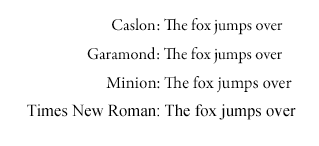
The font for the actual body of the story should be from the “body fonts” part of the (huge) world of fonts. These are normally “serif” fonts (the claims that serif fonts encourage reading flow seem to be in doubt last I checked, but they’re still the traditional choice here). Body text is usually set at around 11-12 points, but it depends a lot on the font. A very few basic choices are Times New Roman, Minion, Caslon, and Garamond (see examples). If you’re not used to looking at fonts, you may not see any difference at all (except in size) between those four! (Minion and times have a higher x height, the ‘j’ and ‘e’ in Times are fairly distinctive, the serif patterns are a bit different, etc. People with decent font knowledge can recognize which of these is on a page with quite brief study.)
The font for chapter titles would normally be a display font (or at least a dual-use font). If you have actual titles, and not just numbers, for your chapters, avoid anything too complex (Magnificat is too complex—by a lot). And they should be several sizes larger, maybe in the 14-20 point range, but this also depends a lot on the font.
Oh, and justify both margins. This is a book, not a term paper.
Decorative dingbats, drop caps for the first letter of a chapter, setting the first half line of each chapter with small caps, and so forth, can all be omitted without loss. (Good designers can do nice things with all of these, in ways that can enhance the reading experience, but if you’re a good designer, you don’t need my advice on this.)
For a novel body there’s really only one right way to paragraph: indent the first line some, around .2 inches maybe. Do not add extra space between paragraphs.
Back up in the front matter, I tend to do the copyright page with non-indented paragraphs with space between them. But not for the body.
Also, turn on widow and orphan control, both set to 2 lines.
So, here’s what a page of my design for the new Blaisdell Press print edition of Pamela’s Juniper, Gentian, and Rosemary looks like:

The body font is Minion, the chapter head is Garamond with small caps.